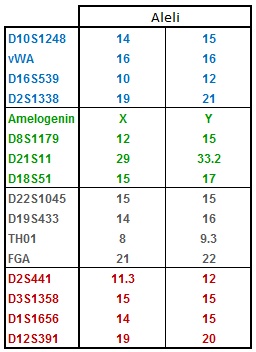DNA profiling of individuals
How does the identification based on DNA work?
Every living thing has DNA sequences that are unique to its type.
Identification of individuals within the human species is based on the analysis of segments of DNA molecules that differ most between individuals. These regions are clearly defined and are called "loci". The result of the analysis is the identification DNA profile that is unique to each person. The only information on characteristics of the person in question you get from such a DNA profile is whether that person is male or female.
The frequency of the "average" profile is of the order of 1 in 10 18 (1 billion billion). This makes It virtually impossible that two people will have the same DNA profile, or that such two people ever existed. The only exception are identical twins.
What does a DNA profile look like?
The table below shows a made up example of a DNA profile which describes 15 different regions (or loci) plus amelogenin (information on the sex of the person).
Loci names, which are used for identification, are given in the first column. Each locus is characterised by a single (identical) or two (different) allelic variants. Allelic variants are numbered. The set of all allelic variants at all loci is the DNA profile of an individual and is unique for each person (except for identical twins).
Allelic variants are inherited from biological parents - one from the father, the other from the mother. It is possible to have two identical allelic variants (in this example, on the loci VWA, D3S1358 and D22S1045).
Locus "amelogenin" provides information on sex: XY for males, XX for females.
